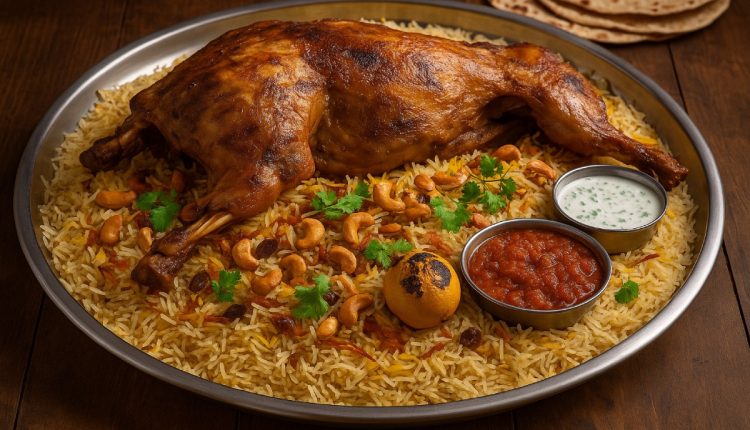The King of Middle Eastern Platters
Few dishes command attention quite like Full Goat Mandi. With its whole roasted goat majestically seated on a bed of long-grain, aromatic rice infused with exotic Arabian spices, mandi is more than just food — it’s a royal banquet, a symbol of hospitality, festivity, and indulgence.
Whether served at weddings, Eid feasts, or festive gatherings, Mandi (originating from Yemen) has now become a pan-Gulf and Indian favorite, especially in cities like Hyderabad, Chennai, and Bengaluru, where food lovers seek that unforgettable blend of spice, smoke, and slow-roasted perfection.
What is Mandi?
Mandi is a traditional Yemeni dish made with:
-
Fragrant basmati rice
-
Meat (chicken, mutton, or goat)
-
A blend of spices known as Hawaij
-
Often cooked in a tandoor-like pit oven for a smoked flavor
The full goat version takes this feast to another level — where the entire goat is marinated, slow-roasted, and served whole over the rice. It’s a true showstopper.
The Showpiece: Full Goat
A young whole goat (5-8 kg) is:
-
Marinated in a mix of yogurt, lemon juice, garlic, ginger, saffron, and spice blends
-
Slow-cooked in a wood-fired oven or wrapped and roasted over coals
-
Brushed with ghee or oil for that golden, crispy finish
-
Often stuffed with nuts, rice, or dried fruits for an extra layer of luxury
The result? A melt-in-mouth texture that tears effortlessly, yet retains the smoky, meaty essence.
The Soul of the Dish: The Mandi Rice
Underneath the goat lies a bed of aromatic rice cooked in the same juices:
-
Spiced with cardamom, cinnamon, cloves, bay leaves
-
Tinted golden with saffron or turmeric
-
Enhanced with fried onions, ghee, raisins, and toasted nuts
-
Sometimes layered with a mild tomato broth or lamb stock
Each bite carries the depth of Arabian spice, the smokiness of meat, and the warmth of traditional hospitality.
How is It Served?
-
The Full Goat Mandi is usually served in a massive round steel or copper thal.
-
The goat is placed whole on the rice, often with a charred lemon or green chilli yogurt dip on the side.
-
Meant to be shared by 8–20 people, it’s the centerpiece of the table.
-
Diners sit around the platter in traditional style, eating with hands and sharing stories.
This isn’t just a meal. It’s an experience.
Must-Have Sides
-
Zhoug or Daqqus – Spicy tomato chutney with garlic
-
Cucumber-onion yogurt raita
-
Lime wedges or pickled vegetables
-
Khubz (flatbread) on the side
-
Mint tea or laban (buttermilk) for digestion
Cultural Legacy
In Arab culture, Mandi symbolizes generosity and honor. Hosting guests with mandi is considered a gesture of deep respect. In South India, particularly among food enthusiasts and wedding caterers, mandi has become a celebration dish, often replacing biryani for large-scale events.
This is especially popular in:
-
Arabian-themed restaurants
-
Eid and Bakrid feasts
-
Nikkah ceremonies and family get-togethers
-
Food influencers’ top reels and YouTube videos!
Who Should Try Full Goat Mandi?
-
Meat lovers craving a smoky, tender experience
-
Large family or friend groups celebrating a special moment
-
Anyone curious about Arabian and Hyderabadi fusion dishes
-
Event caterers looking to elevate their menu
The Experience, In Words
Picture this — a round metal thal, gleaming under soft lantern light. A saffron-hued bed of rice steaming with the scent of cloves and cinnamon. At the center, a golden-brown whole goat, garnished with coriander, nuts, and fried onions, its crisp skin glistening with ghee. The table falls silent for just a moment… before hands dive in, laughter fills the air, and every bite feels like a journey to the Arabian Gulf.
Yes, that’s the power of Full Goat Mandi.


Comments are closed.